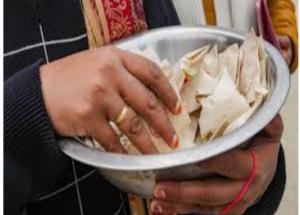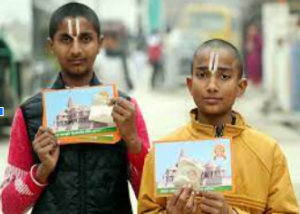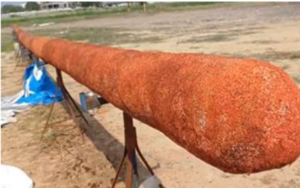22 January
On January 22, 2024, a ‘Pran Pratishtha’ ceremony will be held at the Ram temple in Ayodhya.
It has been officially announced that 22 January 2024 is the scheduled date for the installation of Lord Ram’s idol in the garbhagriha (sanctum sanctorum) by Champat Rai, General Secretary of Sri Ram Janmabhoomi Kshetra Trust.

It is located on the site of Ram Janmabhoomi, the supposed birthplace of Rama, the main deity of Hinduism.
Bhumi Pujan to launch the construction of Ram Mandir was performed by Prime Minister Narendra Modi on 5 August 2020. The temple, which is currently under construction, is under the supervision of Shri Ram Janmabhoomi Teerth Kshetra Trust. The inauguration of the temple is scheduled for January 22, 2024.

January 22, 2024: Celebrating the biggest Diwali

To commemorate this momentous occasion, PM Modi has urged people to light ‘Ram Jyoti’ in their homes and celebrate Diwali on January 22, 2024. This unique celebration is expected to gather millions in symbolic and joyous worship.
According to Hindu mythology, Lord Ram was born at the confluence of Abhijit Muhurat, Mrigashirsha Nakshatra, Amrit Siddhi Yoga and Sarvartha Siddhi Yoga.
Mangal Akshatha
A paper bag containing ‘akshat’, a picture of the Ram temple and a brochure detailing the construction were distributed to the people. A member of Shri Ram Janmabhoomi Trust during the distribution of ‘akshat’, rice grains mixed with turmeric and ghee, at Valmiki Colony on the first day of New Year 2024 in Ayodhya.

The ‘akshat’ distribution ceremony will be performed by people associated with VHP and RSS and their allies. The role of the trust is basically to build the temple and serve as a guiding force, sources said.” This will continue till January 15, when Makar Sankranti is celebrated. Shri Ram”.
In a unique initiative to involve millions of devotees in the upcoming consecration ceremony at Ram Mandir in Ayodhya, religious organizations like VHP, RSS and their allies are distributing revered ‘akshats’ to devotees. The distribution, which began on New Year’s Day, includes rice grains mixed with turmeric and ghee, is considered sacred in Hindu rituals.

Before the distribution of ‘akshat’, the ancient temple of ‘Bhagwan Mathgendra Ji’ echoed with chants of ‘Sita Ram.’ The distribution process includes a paper bag containing ‘akshat’, a picture of the Ram Mandir, and a brochure detailing the structure of the temple with the trust’s logo and an inscription in Hindi – ‘Under-construction Temple, Ayodhya.’
Led by a group of sadhus and young artistes depicting Lord Ram, the distribution aims to reach communities around nearly five thousand temples and touch about five million people across the country. Prime Minister Narendra Modi has urged people to light a special ‘diya’ in their homes on January 22, which he considers similar to ‘Diwali’ celebration.
The revered ‘akshat’ has taken a significant journey and entered homes across the country as a symbol of worship and invitation. It is delivered to every home through Akshat packets. Delivered through specially tailored Akshat packets, this sacred offering has become a moving connection for devotees across the country.

In preparation for the upcoming dedication ceremony of the Ram Temple in Ayodhya, organizers have begun distributing the revered Akshat, a mixture of rice grains, turmeric and ghee, to devotees across the country. The distribution process, which began on New Year’s Day, will continue until January 15, a week before the grand ceremony scheduled for January 22.
Through this initiative, the temple trust is trying to reach out to nearly five lakh temples across the country and provide them with photos of the Ram temple and other details. Rai expressed his intention to reach around five million people in India once the full estimate is available.
A group of sadhus, some carrying cards with the image of the temple and others holding akshat pouches, along with Champat Rai, took part in the procession to begin the distribution process. Young performers dressed as Lord Ram were part of the procession, adding to the festive atmosphere.
Ram Mandir Ghanta
Prana pratistha Ram Mandir program will be held in Ayodhya on January 22, 2024. In the background of this program preparations for the life of Sri Rama began. The mandal pooja will be performed 48 days after the coronation on January 22. Aries devotees from all over the country will participate in this event. A 2100 kg bell will be installed in the courtyard of this Sri Rama temple. The 2100 kg bell became the talk of the whole country.

The country’s largest bell will be installed at the Ram temple in Ayodhya. Price Rs. 25 million crowns were spent on the production of this bell. 400 workers made this bell.
Since last year, the bells from the Ram temple in Ayodhya have been manufactured at the Mittal factory in Jalesar. The workers worked hard day and night to produce the 2100 kg bell. The bell will be delivered to the Ram temple in the last week of December.
Industrialist Aditya Mittal said that for the past three months, work has been going on non-stop to make the giant bell. 25 million rupees were spent to make this bell.
After the bell was made, the first information was given to Uttar Pradesh Chief Minister Yogi Adityanath. This bell is 15 feet wide. So this bell is 5 feet wide inside. The bell took one year to complete.
A bell of 2100 kg, 6 feet high and 5 feet wide was prepared for the Ram temple. This bell is made in Jalesar which is known as Ghungru-Ghanti Nagar.
When you’re working on a bell of this size, the difficulty levels increase manifold,” says Dayal, 50, a fourth-generation bellmaker. “It’s really hard to make sure you don’t make a single mistake during the month-long process. . “What excited us was getting to the Ram temple, but the fear of failure also stayed at the back of our minds,” he says.

A team of artisans in Jalesar town in Uttar Pradesh’s Etah district has forged a bell weighing a whopping 2,100 kg for the new Ram temple in Ayodhya and is preparing to finalize it before sending it to the holy city. While Dau Dayal (50) was primarily responsible for making the ‘ashtadhatu’ bell, Iqbal Mistri (56) was in charge of the design, grinding and polishing. Both pointed out that it was the first time they had ever worked on a bell of this size.
“When you’re working on a bell of this size, the challenges are bigger. It’s really hard to make sure you don’t make a single mistake in the process,” said Dau Dayal.
This makes the task much more difficult. The whole effort will be wasted even if there is a delay.” five seconds while pouring the molten metal into the mold.”
Casting a bell involves many tedious steps – carefully determining the shape and dimensions, cutting wooden templates to make the mold, preparing the metal, tuning, grinding, and fitting the clapper. A team of about 25 workers, both Hindu and Muslim, worked eight hours a day for a month to make the bells, which would be among the “biggest bells” in the country.

The bell cost them Rs 21 crore. From initial plan to design finalization to production, the entire production process took about four months. “Final adjustments need to be done before sending it to Ayodhya,” said Shubham Mittal. The Mittals also presented a 51kg bell to Yogi Adityanath. when he came to Etah to address his first public meeting after becoming Chief Minister.
Ram Mandir Agarbatti
Viha Bharwad, a farmer from Vadodara, Gujarat, created a large 108 feet agarbatti for the inauguration of the Ram Mandir in Ayodhya. Made from Gir cow dung, ghee and various natural materials, it will burn for more than 45 days.
108ft agarbatti for Ayodhya Ram Mandir to burn for more than 45 days, netizens say ‘Poora Desh Mehkega’
A 108 feet long agarbatti was made for the inauguration of the Ram Mandir in Ayodhya. Viha Bharwad, a farmer from Vadodara, Gujarat, has himself made a huge agarbatti to be offered to Ram Lalla.

Agarbatti, which is 3.5 feet wide, symbolizes grandeur. It was made from Gir cow dung, Gir cow ghee, Deodar tree wood, guggul (resin), coconut shells, various herbs, barley and other materials. It took Bharwad six months to do it.
The agarbatti made for the grand dedication ceremony of the Ram Mandir in Ayodhya weighs 3,600 kilograms. So I decided to make the biggest incense stick and light it when the ram temple was inaugurated.
The cost of 108 feet of agarbatti is more than Rs 5 crore. Bharwas spent some money from his pocket, used donations from devotees and also took a loan to prepare agarbatti.
The farmer added that once the agarbatti is lit, the incense stick will burn for more than 45 days.
Bharwad and 25 devotees left Vadodara on January 1 for Uttar Pradesh and will reach Ayodhya by January 18.
Photos and videos of Mandir’s 108-foot agarbatti for the ram are doing the rounds on social media, while excited enthusiasts say, ‘Poora desh mehkega’.
The incense stick contains 3000 kg of Gir cow dung, 91 kg of Gir cow ghee, 280 kg of Devdar tree wood, 376 kg of Gugal, 280 kg of Tal, 280 kg of Jav, 370 kg of crushed copra and 425 kg of Havana material.
The incense stick contains 3000 kg of Gir cow dung, 91 kg of Gir cow ghee, 280 kg of Devdar tree wood, 376 kg of Gugal, 280 kg of Tal, 280 kg of Jav, 370 kg of crushed copra and 425 kg of Havana material.
The truck route will cover Vadodara, Halol, Kalol, Godhra, Shahera, Arvalli, Modasa, Shamlaji, Kherwada, Udaipur, Malvada, Savariya Sheth Mandir, Chittor, Bhilwada, Dadiya, Kishangadh, Jaipur, Ghosa Mahendipur, Bharaji Choraya, Bharaji, Faterpur Sikri , Agra, Lucknow, Itava, Kanpur, Unao, Barabanki and Ayodhya. DeshGujarat

Preparations are in full swing in Ayodhya ahead of the grand opening of the Ram temple in Ayodhya. Various infrastructure projects are underway in the city as the site is expected to host thousands of pilgrims in the coming months after the inauguration of the temple.
Vadodara, Gujarat is making a colossal 108 feet long and 3.5 feet wide incense stick for the inauguration. Weighing 3500 kg and symbolizing majesty, it is composed of Gir cow dung, Gir cow ghee, Deodar tree wood and other significant materials.
“The stick is environment-friendly and lasts for about one-and-a-half months and spreads its fragrance for several kilometers,” Vadodara resident Viha Bharwad, who prepared the incense stick, told PTI.
He said 376 kg of guggul (resin), 376 kg of coconut shells, 190 kg of ghee, 1,470 kg of cow dung and 420 kg of herbs are among the ingredients used for the staff, which is almost half the height of Delhi’s iconic Qutab Minar. The minaret is 237 feet tall.
Mr. Bharwad and 25 other devotees left Vadodara with a huge incense stick on January 1 and their convoy will reach Ayodhya on January 18.





Recent Comments